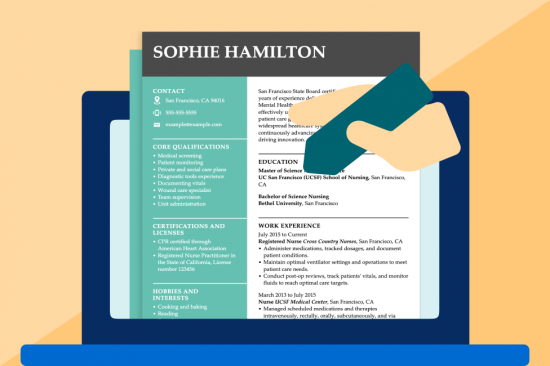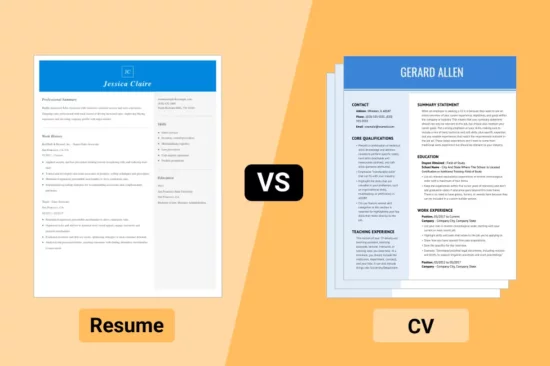How to Write a Resume for a Retired Person
We compiled the best tips to ensure you write a retiree resume showing off your best skills and valuable experience. Read on and start making a smooth transition back into the workforce!
If you’re retired and wish to rejoin the workforce, you’re not alone! Many retired individuals decide they would like extra income or a job to fill their time.
Whatever your reasons for hitting the job market again, you should join the competition with a stellar resume that features valuable skills you’re an expert on, and employers want.
We will help you create a personalized resume in minutes, so you can confidently say you’re applying with a top-of-the-line, modern resume that showcases your expertise — just by following a few easy steps in our Resume Builder.
If you want to try writing your resume from scratch, we’ll teach you everything there is to know about making an impressive retiree resume.
This guide will help you write a resume for a retiree returning to work with the following:
TABLE OF CONTENTS
The best resume format for a
retired person
You may find many resources guaranteeing that there is just one resume format all retired job seekers should use.
However, the truth is that the way your resume should look like can vary for every job seeker. Your ideal resume format depends on many factors, such as time away from the workforce, years of experience and the type of job you want to apply to.
You can write a resume in the chronological, functional or combination format, which you can learn more about in our resume formats guide.
- Benefits applicants with 15+ years of relevant experience.
- Focuses on accomplishments in the work history section.
- Should be used by retirees returning to work in the same industry as before.
- Is ideal for applicants with little to no relevant experience or gaps in their work history.
- Focuses on kills and minimizes work history.
- Retirees should use it if applying for work outside their career industry.
- Is great for career changers or applicants that have been out of the workforce for a while.
- Features some relevant experience but spotlights skills.
- Should be used by retirees who have changed industries.
Which is the best resume format for a retired person? A chronological resume is a good choice if you recently retired from a job and are looking for work in your previous industry. However, a functional resume is the best format if you’ve been out of work for a while or took time off in the middle of your career.
Sections to include in a retired
person’s resume
Once you’ve decided on the appropriate resume format, you can begin by writing the five essential resume sections: contact information, resume summary, work experience, skills and education. Let’s start!
1Contact information
First, include a header for your resume that mentions:
- Your full name
- Phone number
- City and state of residence
- Email address
Make sure you’re using an email account you can easily access and an email address that includes your name.
2Resume summary
Then, craft a resume summary that summarizes your top professional achievements, qualifications and skills in two to three sentences.
Avoid sharing your years of experience if you’ve been in the workforce for more than 20 years to avoid potential hiring bias based on age. But don’t fret about this. A cover letter is another effective way to convince employers of your value as a retiree with a wealth of experience and skills.
Check out these examples:
PRO TIP
If you lack relevant experience and would like to focus on goals, consider writing a resume objective instead.
Resume summary for a retired person
“Charismatic customer service representative, two-time recipient of National Employee of the Year award. Excels in call center environments, chat support and in-person customer support. Possess experience as customer experience manager in the hotel industry. Superb interpersonal, management and leadership skills.”
Resume objective for a retired person
“Diligent and responsible educator applying for the volunteer client coordinator position. Possess excellent organizational skills developed throughout my career, keeping records of more than five student classes each semester. I possess diversity awareness training and empathy that aligns with the organization’s mission to help others regardless of background.”
Feeling inspired? You can find dozens of content suggestions you can copy and paste to your resume summary using our Resume Builder.
3Work experience
Your resume should always include a list of your most recent or relevant job titles in the work experience section.
If you’re writing a chronological or combination resume, you should also expand upon each job title with bullet points describing your achievements within that role.
Instead of listing your job duties and responsibilities, try focusing on what you accomplished.
See how this retired warehouse operations manager frames their daily responsibilities into unique achievements.
Work experience for a retired person
Work Experience
Warehouse Operations Manager — Jan 2007 – June 2019
Office Furniture Warehouse – Cincinnati, OH- Increased team productivity by 67% by employing a project management approach to operations and running a status meeting every week to brainstorm and generate solutions as a team.
- Supervised over 150 weekly deliveries, ensured proper loading and unloading, and kept log sheets accurate and up to date.
- Trained two warehouse workers in leadership, management and warehouse safety standards and mentored them as they were promoted to senior positions.
Using the right words and numbers, you can create a work experience section with recruiters insisting on an interview. Our Resume Builder will use your desired job to generate hundreds of work experience descriptions you can edit and include on your resume.
4Skills
Another crucial section of your resume is the skills section. Here, you showcase skills and qualifications demonstrating your ability to perform your desired job.
A helpful tip we always recommend to retired job seekers is to reread the job description and look out for specific skills or keywords in the job requirements.
If you notice any skills you possess, note them and add them to your skills section. When recruiters scan your resume, they’ll look out for those specific keywords and are more likely to consider you for the job.
Your skills section should include a variety of hard skills and soft skills. Hard skills refer to the abilities you’ve learned to excel in a particular job or industry. Soft skills refer to those personal traits that allow you to work well with others and do your job efficiently.
If you’re trying to figure out which skills you should add to your resume, you can refer to these 250+ skills and learn how to format your skills section based on your chosen resume. You can also just let our Resume Builder generate the top skills for you based on your desired job in mere seconds.
5Education
Although often overlooked, the education section is a great way to show employers you have skills and knowledge validated by an institution. Even if you graduated long ago, this is the sort of achievement that never becomes irrelevant.
However, as a retired job seeker, you don’t want any biased recruiters to guess your age and discard your resume. That’s why you need to omit graduation or attendance dates when listing your education.
Here’s how your retiree education section should look:
Education section for a retired person
Education
M.S. in Civil Engineering
University of California, BerkeleyB.S. in Mechanical Engineering
Arizona State University
5 tips for updating a
retiree resume
1Include only the most relevant information.
You might have decades of experience and skills, but you don’t want to overwhelm recruiters with a 10-page resume. Focus on the qualifications and job experiences that align with the job you want to apply for.
2Consider including additional resume sections.
You don’t have to limit yourself to the five essential resume sections. You can customize your resume with additional sections that help you showcase all you have to offer. For example, you can add a section for Volunteering, Certifications, Languages or any other achievements you deem relevant to the job you want. Our Resume Builder allows you to add custom sections and seamlessly organize them in your resume.
3Always tailor your resume to each role.
A one-size-fits-all resume rarely helps you get all the interviews you want. Not every job will require the same skills and experiences. Therefore, it’s best if you edit your resume each time you apply and make sure you remove irrelevant information in favor of what the job requires.
4Keep applicant tracking systems in mind.
Applicant tracking systems or ATS are computer programs that some companies use to filter out resumes that don’t align with the job requirements. The ATS is easy to bypass if you add keywords and skills from the job description as long as they accurately reflect your abilities. You don’t want to get caught lying and risk a job offer! Check out our tips for writing an ATS-proof resume to ensure your resume is primed for your job search.
5Use a professional resume template.
Nowadays, job postings can receive hundreds of submissions, so you want your resume to stand out. That doesn’t mean having an overcrowded resume template with too many design features and colors. You want a resume template for a retired person that shows professionalism and boldness, just like the ones you can find in our resume template library.
A cover letter that helps
retiree applicants
To increase the chances of an employer hiring a retired worker, include a cover letter that explains your desire to return to the workforce and give them more reasons why they should hire you.
A cover letter is a great companion to your resume!
- It features additional accomplishments you couldn’t fit in your resume.
- Gives you a chance to narrate your career history.
- Provides more context to your achievements.
- Lets you feature even more skills and qualifications.
Learn how to write a cover letter for a retired person with our cover letter writing guide or just take advantage of our Cover Letter Builder, which generates a personalized cover letter in minutes.
Key takeaways for writing
a retiree resume
- Choose the resume format for your unique retiree situation.
- Include a header with your contact information and an updated email address.
- List your work experience in reverse chronological order.
- Mention skills, qualifications and experiences that are relevant to the position.
- Avoid mentioning your graduation dates in your education section.
- Consider custom sections to feature additional achievements.
- Tailor your resume for each job application.
- Use a modern yet simple resume template.
- Complement your resume with a retiree cover letter.
More resources for retired job seekers
Featured in:*

*The names and logos of the companies referred to in this page are all trademarks of their respective holders. Unless specifically stated otherwise, such references are not intended to imply any affiliation or association with LiveCareer.







